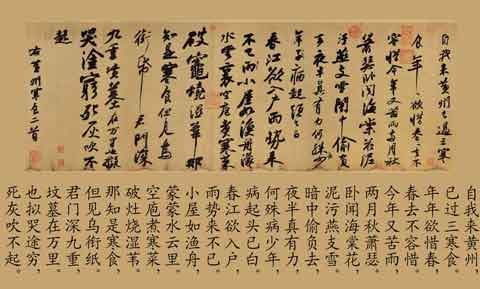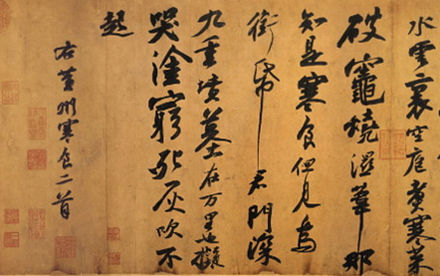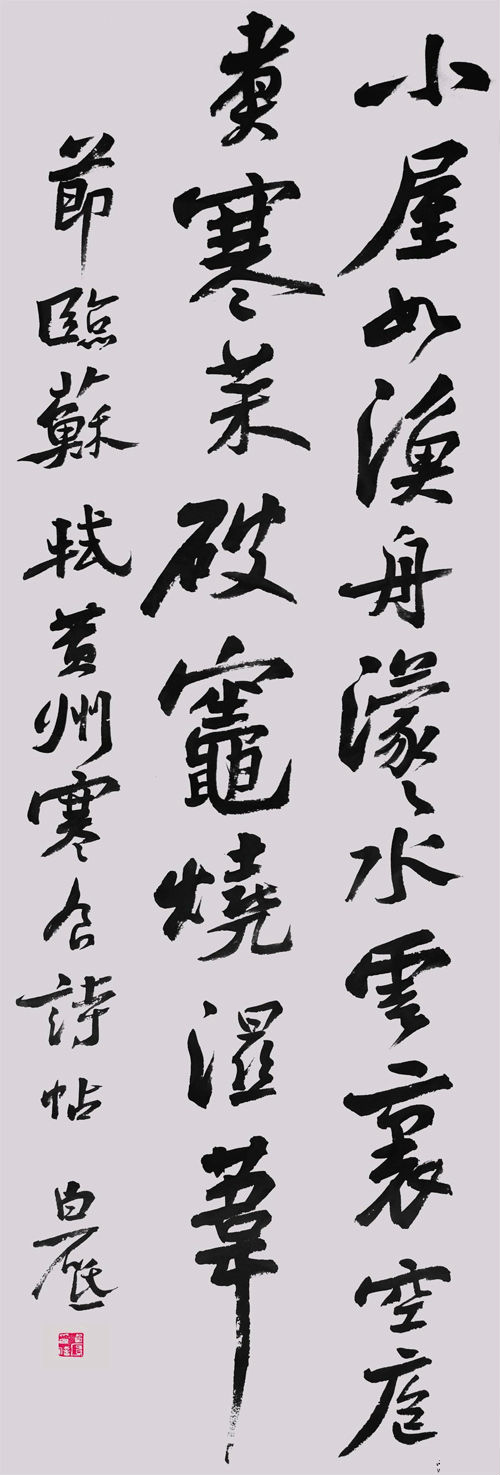Overview of the background of the work
"Poetic Notes on Cold Food" is not only one of the most wonderful representative works in the personal calligraphy career of Su Shi, the great calligrapher of the Song Dynasty, but also an important landmark work in the history of Chinese calligraphy, especially the development history of cursive calligraphy. Later generations referred to it as "Lanting Preface" by Wang Xizhi of the Eastern Jin Dynasty and "Manuscript of Sacrifice to My Nephew" by Yan Zhenqing of the Tang Dynasty, and it was praised as "the third running script in the world". The "first", "second" and "third" here are In fact, it refers to the chronological order, and cannot simply be understood as the difference in artistic level. Therefore, to study and examine the calligraphy style of Shang Yi in the Song Dynasty is to study the development and evolution of the running calligraphy art style genre since the "Two Kings", and there is no way to bypass "Han Shi Tie".

Interpretation of artistic conception of works
These are two poems written by Su Shi when he was demoted to Huangzhou in 1082, the fifth year of Song Yuanfeng's reign. The paper version is now in the collection of the National Palace Museum in Taipei. During the Qingming Festival in March of that year, Su Shi traveled from Huangzhou to Shahu and then to Qishui. He had a short spring outing, which was nothing more than enjoying himself in the midst of suffering. In such difficult and helpless days, Su Shi still maintained the childlike innocence of a scholar and was full of sincere love for life. This is the endearing aspect of Su Shi's character. It is precisely because of this that the "Poetry on Cold Food" is created, which is a combination of poetry and calligraphy. These are two poems. The first is from "I came to Huangzhou" to "The beard has turned white since the illness began", and the second is from "Spring River is about to enter the house" to "The ashes cannot blow". In the poem, the author describes the miserable living conditions in the three years since Bianjing was demoted to Huangzhou, and expresses his sentimental feelings of wanting to cry but feeling helpless. Therefore, we cannot simply regard this work as an ink mark or a "good calligraphy". Before we start writing, we must carefully read the content of the poem, carefully appreciate the author's emotions and state of mind, and feel the author's time and place. The rhythm of life when the earth is moistened with ink. After reading and appreciating it for a long time, we will slowly and unknowingly close the distance with the author. We intuitively feel that the author is a kind elder beside us, telling us the misfortune and anger of fate. The stippling lines create a sense of intimacy with us and "come alive" before our eyes. Based on this reading experience, let us further understand the extraordinary features of Su Shi's writing from the overall composition and layout. The first poem focuses on narrating, "I came to Huangzhou, and it has been three years of cold weather", and it has been raining hard every year, so that "the beard has turned white since the disease started." The emotion is low, and the rhythm of the pen and ink is also plain and slow. The fourth and fifth lines have a slight ups and downs, but the sixth and seventh lines return to calm. In contrast, the second song is quite passionate and pathos. The three lines from "Spring River is about to enter the house" to "Cooking cold vegetables in an empty blister" are written quickly, vigorously and fiercely, as if a piece of music is about to reach its climax. The foreshadowing is brewing, and in the eleventh line, "Break the stove and burn the wet grass" suddenly sounds like the strongest note of the whole piece of music, which suddenly makes the author's angry and sad emotions burst out and vent. The next few lines progressed one after another. In the difficult days, people actually forgot about the cold food festival of worshiping ancestors and burning paper. When they saw the birds flying away with paper in their hands, they thought that it was already the Qingming Festival. An important minister who used to go to the palace, A talented scholar was exiled to a foreign country thousands of miles away from home. How could this situation not touch the sensitive heart of the poet? He missed his hometown, relatives and ancestors, and couldn't help but "I also wanted to cry about being so poor and dying." "I can't afford to blow it." I feel like I am nostalgic for my country and want to cry without tears. It can be seen that the special significance of this thousand-year-old immortal work lies not only in the exquisiteness of its pen and ink, but also in the harmonious unity of its poetic charm and the author's personality. This is the author's eternal compassion for mankind with a "big heart" The freehand brushwork and comfort of emotions have a strong artistic appeal that will last for thousands of years.
The relationship between poetry and calligraphy
We cannot simply apply our understanding of Su Shi's poems to our understanding of his calligraphy art. Understanding the content of writing cannot replace the understanding of the ontology of calligraphy art.

As a calligrapher, Su Shi was an advocate and practitioner of the Shangyi style of calligraphy in the Song Dynasty. His artistic views of "creating new ideas and not imitating the ancients" and "not intending to improve the quality" had an impact on the cursive calligraphy style of the Song Dynasty and even beyond. huge. The word "meaning" naturally reminds us of the interest and taste of aesthetic images such as "interest", "meaning", "meaning", and "artistic conception". Xiong Bingming explained it in "Theoretical System of Chinese Calligraphy" as "a quiet and pleasant creation", emphasizing the lyricism in creation, which is quite accurate. Based on this artistic field, Su Shi's brushwork skills were more relaxed and natural than his predecessors such as the "Shang Fa" Tang Dynasty, and he valued adaptability and freedom more. This cannot help but talk about his unique writing method - the lying writing method. What is "lying down"? "Shuowen" explains it this way: "Yan: stiff. Anyone who looks up to his servant says Yan." His friend Chen Shidao should be very familiar with Su Shi's writing. He described it like this: "Dongpo writes with his hand on the case, so that his wrist does not move. Method." It can be seen that "zhuang" means "immovable", and "yangpu" means that the tip of the brush is at a certain angle with the paper surface, rather than upright. When the brush is stroked, the tip of the brush will naturally often In a prone state. "To hold the case with the hand" means that the writing is very low, with the wrist resting on the wrist and not hanging above the wrist. Because writing on the pillow and wrist can only be based on movement of the fingers, the room for maneuver of the calligraphy pen is relatively narrow. The advantage of this writing method is that the strokes of line stipples are very smooth and smooth, just like the hanging needles in the four characters "year", "zhong", "reed" and "paper". The writing is very strong, strong and smooth. It is dripping and breaks the dull and depressing feeling of Su Zixi's flat posture, which plays a finishing touch in the whole work. The disadvantage is that the body feels tight and not stretched enough. Huang Tingjian ridiculed Su's characters like "a shrimp is pressed by a stone" and said: "Maybe Yun Dongpo's Ge Duo became a diseased pen, and his wrist was held while the pen was lying down, so the left side is beautiful and the right is withered." Dong Qichang wrote in his "Essays on Painting a Zen Room" "" also said: "Po Gong's writings are often sloppy, which is also a disease." Therefore, when we write this post, we have to pay attention to these characteristics. We must be familiar with Su Shi's more special writing method, and we must strive to The writing should be like it, both form and spirit; but it should not be copied by the smile or frown, and only the appearance will be copied. In the end, the expression will not be captured, but a lot of defects will be left.
Four key points in confronting "Han Shi Tie"
We know that Lin Tie contains "face to face" and "meaning to face". Let’s talk about Lin first. Specifically, we should pay special attention to the following aspects:
1. Stipulation of typical lying postures,For example, when writing words such as "Lai", "Huang", "Liang", "Shao", "Na", and "Death", the dots should not be bloated and lackluster due to excessive pursuit of similarity. , the pen should be lifted appropriately and slowly. In particular, the parts where the painting is turned and cut should be properly restrained.
2. The fonts are mostly flat.The left side is low and the right side is high, the left side is relaxed and the right side is frowning, in an inclined shape. When drawing horizontally, use Shunfeng at the beginning of the stroke, without hiding it. When writing, you must grasp these characteristics, and your strokes must be cut and plain, not sharp or weak. In addition, there are also some long and vertical characters mixed in, such as the word "年" in the second line, the word "中" in the fifth line, the word "里" in the tenth line, and the characters "zao" and "wei" in the eleventh line. "", the word "paper" in thirteen lines, etc., form a sharp contrast with the overall tone of the whole article, which is flat and horizontal, and full of changes. When writing, you should pay attention to these changes, especially the hanging pins of the four characters "year", "zhong", "reed" and "zhi". The pen must be deep and the ink is full and powerful, showing an unstoppable force. The momentum surged thousands of miles, dripping with joy.
3. Pay attention to the size changes of the fonts.The size of the fonts in this post varies greatly and the contrast is strong. The small ones are like "Ji", "Go", "You", "Yu", "White", "Wanli", etc., and the big ones are like "Nian" and "Pozao". ", "The road is poor", etc., are several times or even ten times different, scattered and scattered, like big beads and small beads falling on a jade plate, natural and vivid. When writing, pay attention to make full use of the sharp points of the small ones and strive to be flexible and flexible; while the large ones should write decisively and hard to achieve full strength and emotional connotation.

4. The outstanding feature of this post’s composition is that the word spacing is tight and the line spacing is loose.For example, in the fourth, fifth, ninth, tenth, eleventh, and fourteenth lines, there are almost no gaps between the characters, especially the vertical bottoms of the four hanging needles are almost interspersed with the characters below. It is extremely rare in famous calligraphy of all ages. This kind of tense and depressing space atmosphere is very consistent with the emotional tone of the author's poems. It should be carefully grasped when writing. In addition, we should also pay attention to the positive and oblique swing of the axis of each row and the changes in density between rows. This change makes the whole work full of strong rhythm. For example, in the first row, the word "Huangzhou" tilts to the lower right. The word "three colds" is tilted to the left and down, the eighth line is also right first and then left, the thirteenth line "holds the paper to the king's door deep" is tilted to the left, and the fifteenth line is tilted to the bottom and right again, tightening . Judging from the changes in line spacing, the first seven lines, that is, the first poem, are relatively even. Starting from the eighth line, they become looser and tighter, growing with the situation, creating a strong sense of movement. At the same time, in addition to grasping the above aspects, when choosing tools and materials, you should also pay attention to using langhao or jianjian pens as much as possible. For paper, it is better to use half-baked antique paper in order to control the excessive ink. Permeate.
It is equally important to read "Han Shi Tie"

When writing this post, it is very necessary to be realistic, otherwise we will not be able to appreciate the subtleties of the details of the original post, and we will not be able to solve the problem of learning the techniques of the ancients. However , it is more meaningful to study "Han Shi Tie" based on the meaning between similarity and dissimilarity. The reason is:
First, the cursive script is different from the static calligraphy style of regular script and seal script., is extremely dynamic, and a certain writing speed must be maintained during the writing process. It is extremely natural to follow the situation and form the momentum. It is difficult to make the final writing exactly the same as the original, as Huang Tingjian here The postscript after the post said: "If we try to restore Dongpo, it may not be as good as this."
Secondly, Su Shi’s method of using pen is quite special.This three-finger "crouching" style of writing with low control may be an indirect way of "turning decay into magic" for Su Shi, but for us, it may become a problem, at least it is not in line with the way most of us write. Habits, there is really no need to imitate them deliberately. Third, when studying calligraphy, we should treat the ancients as our guests. This is the experience of our predecessors. After all, copying the calligraphy is a means rather than an end. From the experience, understanding and practice of the ancient classics, we can gain an enlightenment and find a way. Developing a set of techniques and applying them to our own writing and creation is our most fundamental purpose and the most meaningful.









